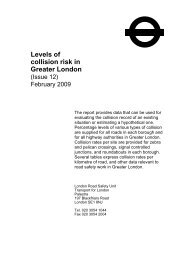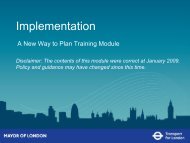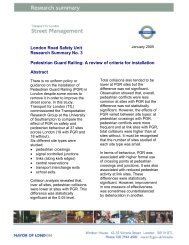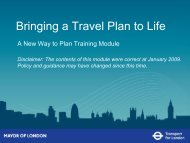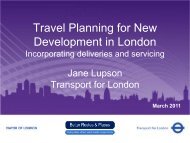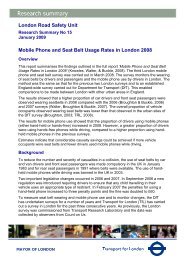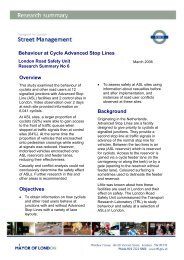An evaluation of the Safe Drive Stay Alive road safety presentation ...
An evaluation of the Safe Drive Stay Alive road safety presentation ...
An evaluation of the Safe Drive Stay Alive road safety presentation ...
- No tags were found...
You also want an ePaper? Increase the reach of your titles
YUMPU automatically turns print PDFs into web optimized ePapers that Google loves.
515. Conclusions5.1 SDSA impactOverall <strong>the</strong> <strong>Safe</strong> <strong>Drive</strong> <strong>Stay</strong> <strong>Alive</strong> event was received well by <strong>the</strong> majority <strong>of</strong>students. The format <strong>of</strong> <strong>the</strong> show was not something <strong>the</strong> attendees were expectingand this helped catch and hold <strong>the</strong>ir attention. <strong>Safe</strong> <strong>Drive</strong> <strong>Stay</strong> <strong>Alive</strong> used a differentapproach to that <strong>of</strong> o<strong>the</strong>r, more standardised, <strong>road</strong> <strong>safety</strong> talks and <strong>the</strong> studentsseemed to appreciate this.The raw emotion presented in <strong>the</strong> testimonies, combined with <strong>the</strong> realism and detail<strong>of</strong> <strong>the</strong> stories told, heightened levels <strong>of</strong> engagement amongst students. This wasparticularly <strong>the</strong> case for <strong>the</strong> speeches given by <strong>the</strong> Fire Officer and <strong>the</strong> bereavedparent (<strong>the</strong> former working particularly well on male student who were generally lesspositive than females when rating all o<strong>the</strong>r aspects <strong>of</strong> <strong>the</strong> day).Despite students‟ initial shock to <strong>the</strong> shows content, it was deemed as beingappropriate for <strong>the</strong> target audience and <strong>the</strong> local angle to communications helpedincreased <strong>the</strong> relevance <strong>of</strong> messages.A consistent <strong>the</strong>me that came across through <strong>the</strong> research was female studentsbeing more receptive to <strong>the</strong> event than <strong>the</strong>ir male counterparts.Students were more receptive to messages deriving from a situation where <strong>the</strong> causeand effect was explicit. This involved highlighting what <strong>the</strong> driver had been doingwrong, what consequences this had, and how that behaviour affected him and thosearound. Such a relevant (to <strong>the</strong> safe driving <strong>the</strong>me) and direct causal effect was<strong>of</strong>ten lacking in <strong>the</strong> testimonies, where some <strong>of</strong> <strong>the</strong> collisions were cause byextraneous factors that had little to do with <strong>the</strong> drivers‟ behaviour/ misbehaviour. Itmay be worthwhile considering including scenarios where a driver was directlyinvolved in causing a collision who can reflect on <strong>the</strong>ir actions and <strong>the</strong> long-termconsequences in future events.5.2 SDSA effectivenessThe overall effect <strong>of</strong> <strong>the</strong> SDSA <strong>presentation</strong> on students was minimal, with evidence<strong>of</strong> only a small improvement in <strong>the</strong>ir intentions and perceived behavioural control




